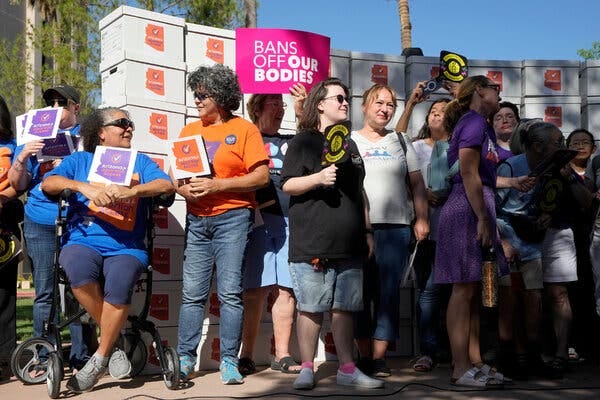Reading the headlines over the last couple of days, you would think the biggest political story about this election is Trump’s pathetic attempt to challenge Vice President Kamala Harris on the size of her rally crowds. Look at this Truth Social post! Trump says she used AI to create fake photos of her crowd at an airport in Detroit! There was even a story in my newsfeed from a polling expert pointing out that you cannot calculate support for a candidate by crowd size. If crowd size were what mattered, Bernie Sanders would be president by now, he reminded us.
Political narratives are strange beasts – at least they were until Trump came along and made them even stranger. It used to be that fights over policies and personalities and the pasts of politicians drove elections. When John Kerry ran in 2006, Republicans took his war record in the Navy in Vietnam and “Swift-boated” him by twisting his service into something it wasn’t. They’re trying to do the same thing with Tim Walz right now, creating a fake story that he was somehow derelict in his duty when he retired from 24 years of service in the National Guard to run for congress not long before his unit in Minnesota was deployed to Iraq.
Then Trump showed up and proved that you can do it using lies alone. That’s what his ridiculous story that Kamala Harris is using AI to fake her crowd size was. Trump proved that if you tell enough lies again and again and again, something will stick, and then you can run with it.
You will notice in the above paragraphs that the political narratives I gave as examples were all driven by men: Men running for office; men’s careers being dissected and put on display; men using lies and misinformation to create stories about each other where there really aren’t any. Even the political narrative about Hillary Clinton during her presidential run in 2016 was created by men: Roger Stone interfacing with Guccifer II to get Hillary’s emails leaked to the press; Trump taking the fake “issue” about “her emails” and making it a central feature of his campaign.
But this week, a campaign narrative driven by women entered the picture in a big way. On Monday, Arizona election officials announced that they had received enough signatures on petitions – in fact 50 percent more than was required – to put access to abortion on the ballot in November. On Tuesday, Missouri officials certified enough petition signatures to allow a measure on the November ballot that would enshrine the right to abortion in the state’s constitution.
Both of these things are a big, big deal. The drives to collect enough signatures to get the referendum measures on the Arizona and Missouri ballots were run by women. Referendums on abortion have already been approved for a November vote in Florida, Nevada, Colorado, and South Dakota. Petitions have been submitted in Nebraska and Montana for similar abortion ballot measures and await approval by election officials. State constitutional amendments will be on the ballot in New York and Maryland that will guarantee access to abortion as well. The New York Times reminded us in a story today that ballot measures guaranteeing a right to abortion have passed in all seven states where they have been put to a vote since Roe v Wade was overturned in 2022. The red states of Kentucky and Kansas were among the states that passed abortion rights measures by referendum.
Arizona and Nevada are crucial battleground states in the presidential election that will be decided in November. Having the issue of abortion on the ballot alongside the decision to vote for either Kamala Harris or Donald Trump, who brags about having appointed three of the Supreme Court justices who overturned Roe, is expected to help Democrats from Vice President Harris on down the ballot, including pivotal races that will determine control of the House and the Senate next year.
Abortion is not just a so-called “women’s issue.” Until two years ago, the right to abortion was embedded in the language of the 14th Amendment which guarantees equal protection of the laws for all. It was part of the central argument that established a right to privacy in Griswold v. Connecticut in 1965, which involved the right of couples to use birth control. The fight over abortion rights, often framed as the right of a woman to control her own body, also involves the right to privacy for all of us. Right wing lawsuit-factories such as the Alliance Defending Freedom have already stated their intention to sue to overturn Griswold, as well as other Supreme Court decisions based on the 14th Amendment involving same sex marriage and the right to love whoever you want in any way you want in the privacy of your bedroom.
With Kamala Harris running for president, Democrats will have the opportunity to emphasize that so-called kitchen table issues such as inflation and taxes are also women’s issues because our candidate is a woman, and that is a good thing. It is definitely a good thing that abortion will be on the ballot in at least two key swing states, and it's even better thing that the person driving the political narrative for the Democratic Party this year is a woman.




Please include activated young voters in this group — women and men! My cohort of 30-somethings is fired up and ready to go. They understand the stakes on all fronts, from personal autonomy to defending democracy. They will vote blue full ballot.
Rosie the Riveter said it all - The only inequality that exists between the sexes is when it is applied to the benefit of the male.
With all Due Respect - YOU GO GIRL!!!!
(translate that to "we men have screwed things up enough. We NEED you to help sort this f'ing mess out")